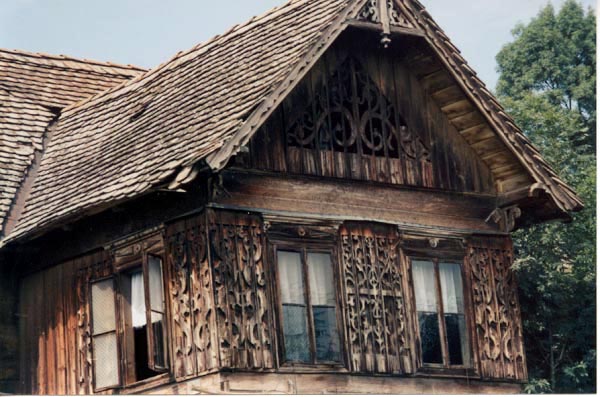 CHARM
OF TUROPOLJE AND VUKOMERICKE GORICE Southeast of Zagreb,
on the hills of Vukomericke gorice and the Turopolje lowlands
from the River Sava to the northeast and the Kupa to the
southwest covering up the area of 566 square kilometres,
stretches the region of Velika Gorica. The population of
about 70.000 inhabitants resides in the town of Velika Gorica,
municipality of Pokupsko, Orle and Kravarsko. The economy
of the region is based on wood processing industry, food
industry, construction, leather processing and graphic industries
and last but not least land cultivation. CHARM
OF TUROPOLJE AND VUKOMERICKE GORICE Southeast of Zagreb,
on the hills of Vukomericke gorice and the Turopolje lowlands
from the River Sava to the northeast and the Kupa to the
southwest covering up the area of 566 square kilometres,
stretches the region of Velika Gorica. The population of
about 70.000 inhabitants resides in the town of Velika Gorica,
municipality of Pokupsko, Orle and Kravarsko. The economy
of the region is based on wood processing industry, food
industry, construction, leather processing and graphic industries
and last but not least land cultivation.
Many cultural
and historic monuments whose traces can be found as far
back as prehistoric times characterize this region. Unique
feature of Turopolje are wooden chapels and aristocratic
kurijas (traditional wooden country houses) often referred
to as Turopolje beauties. Vicinity of Vukomericke gorice,
and the rivers Lomnica, Sava and Odra add to the versatility
of the Turopolje region. The area is rich in oak, one of
the main natural resources. Oak is the reason why these
famous wooden sacral and temporal buildings were built.
Not far from Velika Gorica you can see the old �Turkish�
common oak, which is a protected monument of nature.
VELIKA GORICA is only 16 km away from Zagreb, it is in a
way retained as broader Zagreb area. In the immediate vicinity
of the village of Pleso is the Zagreb airport. The main
road and railway line connecting Zagreb and Sisak pass through
Velika Gorica. Some 33.000 inhabitants live there. Not far
from the town is an intersection of major highways, which
all gives Velika Gorica an extremely good position.
Valuable
archaeological sites have been located in Velika Gorica
and its environs. These date back to prehistoric times (burial
grounds), ancient times (graves from the period of early
Roman emperors) and early Middle Ages (different artefacts,
china that was used in Carolinian cultural circle).
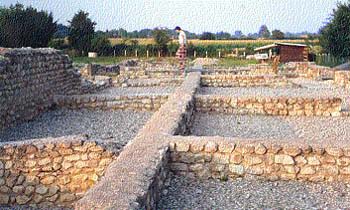 ANDAUTONIA
- ROMAN HERITAGE �citarjevo, a settlement 8 km northwest
of Velika Gorica, is the home of many valuable and important
archaeological sites. This is where Andautonia, the seat
of an Illyrian tribe and a Roman municipality, used to be.
The town was built in the shape of an irregular hexagon.
Archaeologists found the remains of Roman buildings, thermal
complex, roads, wall paintings, plastering featuring herbal
decorations. They also found tools, tableware, glassware,
jewellery, money from the period between the 1st and 4th
centuries. Altar dedicated to the god of the River Sava
was also found, along with reliefs. A relief featuring Nemesis
might lead to a conclusion that Gladiator games were once
held most probably in an amphitheatre made of wood. Stone
monuments were found scattered around farmyards. The traces
of ancient Roman times were found in Donja Lomnica as well
(5 km west of Velika Gorica): the remains of a Roman road
and a grave from the 2nd century. In Bu�evac, 10 km southeast
of Velika Gorica the remains of ancient Roman road were
also found. ANDAUTONIA
- ROMAN HERITAGE �citarjevo, a settlement 8 km northwest
of Velika Gorica, is the home of many valuable and important
archaeological sites. This is where Andautonia, the seat
of an Illyrian tribe and a Roman municipality, used to be.
The town was built in the shape of an irregular hexagon.
Archaeologists found the remains of Roman buildings, thermal
complex, roads, wall paintings, plastering featuring herbal
decorations. They also found tools, tableware, glassware,
jewellery, money from the period between the 1st and 4th
centuries. Altar dedicated to the god of the River Sava
was also found, along with reliefs. A relief featuring Nemesis
might lead to a conclusion that Gladiator games were once
held most probably in an amphitheatre made of wood. Stone
monuments were found scattered around farmyards. The traces
of ancient Roman times were found in Donja Lomnica as well
(5 km west of Velika Gorica): the remains of a Roman road
and a grave from the 2nd century. In Bu�evac, 10 km southeast
of Velika Gorica the remains of ancient Roman road were
also found.
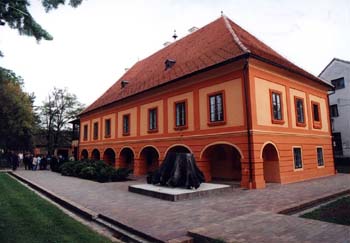 ARISTOCRATIC
TUROPOLJE MUNICIPALITY In Velika Gorica region you�ll be
able to see valuable monuments from later periods. In the
town centre for example you can visit the so-called Turopolje
grad. It is in fact a one-storey building square-shaped
with a porch facing the park. It was built somewhere around
the year 1765. This used to be the seat of �Aristocratic
Turopolje Municipality�. In the upstairs hall decorated
with stucco and fresco ornaments the assembly meetings used
to be held. Today this building is the house of the Museum
of Turopolje that was established in 1960. The Museum has
archaeological, ethnographic, cultural and historic collections.
The parish church of the Annunciation built between 1686
and 1990 was restored in 1893 by architect H. Boll� in classicist
style. The church furniture is from that period, too. ARISTOCRATIC
TUROPOLJE MUNICIPALITY In Velika Gorica region you�ll be
able to see valuable monuments from later periods. In the
town centre for example you can visit the so-called Turopolje
grad. It is in fact a one-storey building square-shaped
with a porch facing the park. It was built somewhere around
the year 1765. This used to be the seat of �Aristocratic
Turopolje Municipality�. In the upstairs hall decorated
with stucco and fresco ornaments the assembly meetings used
to be held. Today this building is the house of the Museum
of Turopolje that was established in 1960. The Museum has
archaeological, ethnographic, cultural and historic collections.
The parish church of the Annunciation built between 1686
and 1990 was restored in 1893 by architect H. Boll� in classicist
style. The church furniture is from that period, too.
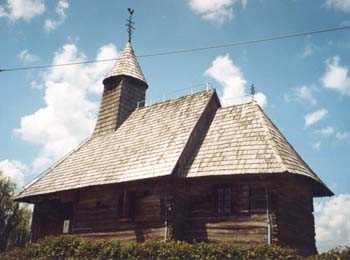 In
�citarjevo you should also see the church of St. Martin
that was first mentioned in 1334. The church was reconstructed
in the first half of the 18th century. It is a single-nave
church with sacristy adjacent to a round-shaped shrine,
steeple next to the main facade and a side chapel representing
the older part of the church. Around the church is a fence
that was built in 1772. Inside the church one can see partly
preserved Baroque artefacts: statues, monstrance (1765),
two reliquaries, bells from 1630 and 1761 respectively. In
�citarjevo you should also see the church of St. Martin
that was first mentioned in 1334. The church was reconstructed
in the first half of the 18th century. It is a single-nave
church with sacristy adjacent to a round-shaped shrine,
steeple next to the main facade and a side chapel representing
the older part of the church. Around the church is a fence
that was built in 1772. Inside the church one can see partly
preserved Baroque artefacts: statues, monstrance (1765),
two reliquaries, bells from 1630 and 1761 respectively.
The attraction
of Donja Lomnica is a Modic-Bedekovic wooden one-storey
kurija from 1806.The kurija is a beautiful example of the
original secular country architecture that used to be built
by the members of lower aristocracy.
 Nine
kilometres west of Velika Gorica is a Baroque castle Lukavec.
This square-shaped castle features the inner ward with arcades
and four prismal towers on each corner. Above the entrance
with a Baroque portal and coat of arms from 1752 there is
a high tower. Under the tower there was a chapel of St Lucy
in which assembly meetings of the Turopolje aristocracy
used to be held. The castle is surrounded by a ditch and
has embrasures. In front of the castle there used be a town
made of wooden houses first mentioned in the 15th century. Nine
kilometres west of Velika Gorica is a Baroque castle Lukavec.
This square-shaped castle features the inner ward with arcades
and four prismal towers on each corner. Above the entrance
with a Baroque portal and coat of arms from 1752 there is
a high tower. Under the tower there was a chapel of St Lucy
in which assembly meetings of the Turopolje aristocracy
used to be held. The castle is surrounded by a ditch and
has embrasures. In front of the castle there used be a town
made of wooden houses first mentioned in the 15th century.
In Vukovina,
4 km southeast of Velika Gorica there is a late Baroque-Classicist
parish church of St Mary. This is a single nave church,
the dome with lantern is above the nave while the apse of
the shrine is oval. Adjacent to the shrine is sacristy.
The steeple was built later. The church furniture originates
from the period when the church was reconstructed i.e. around
1805 and some objects are from the baroque period, chalice
for example. In the neighbouring Stari Cic don�t miss the
wooden parish kurija from 1831. A single nave wooden kurija
called Alapic, with rococo details, features a high hipped
roof.
 WOODEN
BEAUTIES Turopolje is widely known for its wooden architecture.
Temporal and sacral wooden buildings have the same features,
the same elements and materials used, and the same rustic
manner of processing applied. The only difference is that
church builders had more opportunity to show their artistic
abilities when decorating. WOODEN
BEAUTIES Turopolje is widely known for its wooden architecture.
Temporal and sacral wooden buildings have the same features,
the same elements and materials used, and the same rustic
manner of processing applied. The only difference is that
church builders had more opportunity to show their artistic
abilities when decorating.
One of
the distinct features of wooden churches of Turopolje, especially
those built earlier, are the entrance halls that were sometimes
painted. Walls and ceilings were decorated sometimes even
the choir. Each of these churches also had a small tower
above the entrance hall. The floor was usually made of brick,
somewhere oak was used. The inventory was mostly Baroque,
and sometimes a bit rustic.
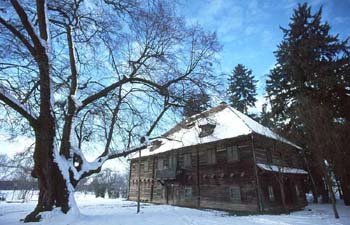 A
wooden chapel of St. Barbara in Velika Mlaka is the most
attractive and certainly the most representative example
of wooden church architecture in Croatia. The chapel was
built in 1642 and reconstructed several times. The present
look was given to the chapel in 1867 when a steeple was
added to it, which was thoroughly restored between 1972
and 1977. This chapel is single nave with trilaterally shaped
shrine next to sacristy. The chapel is richly decorated.
Wooden panelling is painted with ornaments, flowers in vases
and pictures of saints. Among the latter the most interesting,
from iconographic point of view, is St Kummernisse with
a donor M. Basarovic (1759). Several masters participated
in the painting of the chapel, which lasted from 1710 to
1759. The oldest layer from 1699 was destroyed. The wing
altar of St Barbara (1679) features the scenes from the
Saint�s life and those from the Passion of Christ. The altars
of the Blessed Virgin Mary of Snow from 1701 and of the
Lord�s Assumption from 1759 are to be mentioned also. The
bell from 1642 is the work of C. Seisser from Graz. A
wooden chapel of St. Barbara in Velika Mlaka is the most
attractive and certainly the most representative example
of wooden church architecture in Croatia. The chapel was
built in 1642 and reconstructed several times. The present
look was given to the chapel in 1867 when a steeple was
added to it, which was thoroughly restored between 1972
and 1977. This chapel is single nave with trilaterally shaped
shrine next to sacristy. The chapel is richly decorated.
Wooden panelling is painted with ornaments, flowers in vases
and pictures of saints. Among the latter the most interesting,
from iconographic point of view, is St Kummernisse with
a donor M. Basarovic (1759). Several masters participated
in the painting of the chapel, which lasted from 1710 to
1759. The oldest layer from 1699 was destroyed. The wing
altar of St Barbara (1679) features the scenes from the
Saint�s life and those from the Passion of Christ. The altars
of the Blessed Virgin Mary of Snow from 1701 and of the
Lord�s Assumption from 1759 are to be mentioned also. The
bell from 1642 is the work of C. Seisser from Graz.
 Wooden
chapel of the Holy Apostles in Bu�evac was made in 1768.
The interior of the chapel is pained with figures and ornaments.
It features altars, chalices and mass vestments from the
periods between the 17th and 19th centuries. In Pleso near
the Zagreb airport is the chapel of the Wounded Christ that
was built in 1758 by the widow of Ladislav Plepelic, local
nobleman. Local masters restored the chapel and today people
come to admire its facade decoration. Wooden
chapel of the Holy Apostles in Bu�evac was made in 1768.
The interior of the chapel is pained with figures and ornaments.
It features altars, chalices and mass vestments from the
periods between the 17th and 19th centuries. In Pleso near
the Zagreb airport is the chapel of the Wounded Christ that
was built in 1758 by the widow of Ladislav Plepelic, local
nobleman. Local masters restored the chapel and today people
come to admire its facade decoration.
The chapel
of St Anthony of Padua in Gustelnica was first mentioned
in 1678, and throughout centuries it was to be restored,
repaired and even built all over again. Today�s chapel was
built in 1888 where previous chapels stood. Construction
of the chapel of St Rocco on Cvetkovic hill started in 1867,
but the chapel was completed in 1888.
 TRADITION
OF BUILDING IN WOOD The size of wooden churches in Turopolje
ranges from 4 x 2 m in Gustelnica to some 18 x 6 m in Velika
Mlaka. Even though the tradition of using wood as the main
building material has gone well into the 20th c. only five
sacral objects have been preserved. These are: the chapels
in Bu�evac, Gustelnica, Pleso, Velika Mlaka and one on Cvetkovic
hill. Another six churches and chapels are located in the
neighbourhood but considered to be in the area that is outside
the Turopolje region border what makes up the total of 11
preserved wooden sacral objects. TRADITION
OF BUILDING IN WOOD The size of wooden churches in Turopolje
ranges from 4 x 2 m in Gustelnica to some 18 x 6 m in Velika
Mlaka. Even though the tradition of using wood as the main
building material has gone well into the 20th c. only five
sacral objects have been preserved. These are: the chapels
in Bu�evac, Gustelnica, Pleso, Velika Mlaka and one on Cvetkovic
hill. Another six churches and chapels are located in the
neighbourhood but considered to be in the area that is outside
the Turopolje region border what makes up the total of 11
preserved wooden sacral objects.
THE BIGGEST
ACHIEVEMENT IN BUILDING Wooden churches and chapels have
stood as signs of unique value of Turopolje ever since early
Middle Ages. Moreover in the 17th century when Turkish attacks
were common, it was customary to rebuild in wood even those
churches that originally were made of other materials.
These
wooden churches and chapels are the biggest achievement
of folk Baroque architecture in north Croatia.
|


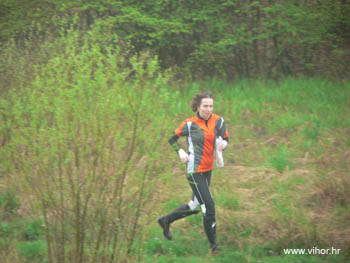


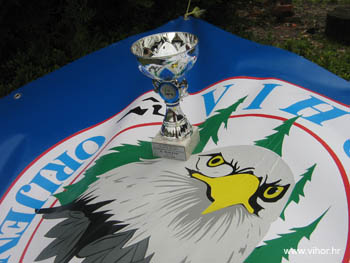








 CHARM
OF TUROPOLJE AND VUKOMERICKE GORICE Southeast of Zagreb,
on the hills of Vukomericke gorice and the Turopolje lowlands
from the River Sava to the northeast and the Kupa to the
southwest covering up the area of 566 square kilometres,
stretches the region of Velika Gorica. The population of
about 70.000 inhabitants resides in the town of Velika Gorica,
municipality of Pokupsko, Orle and Kravarsko. The economy
of the region is based on wood processing industry, food
industry, construction, leather processing and graphic industries
and last but not least land cultivation.
CHARM
OF TUROPOLJE AND VUKOMERICKE GORICE Southeast of Zagreb,
on the hills of Vukomericke gorice and the Turopolje lowlands
from the River Sava to the northeast and the Kupa to the
southwest covering up the area of 566 square kilometres,
stretches the region of Velika Gorica. The population of
about 70.000 inhabitants resides in the town of Velika Gorica,
municipality of Pokupsko, Orle and Kravarsko. The economy
of the region is based on wood processing industry, food
industry, construction, leather processing and graphic industries
and last but not least land cultivation.
 ANDAUTONIA
- ROMAN HERITAGE �citarjevo, a settlement 8 km northwest
of Velika Gorica, is the home of many valuable and important
archaeological sites. This is where Andautonia, the seat
of an Illyrian tribe and a Roman municipality, used to be.
The town was built in the shape of an irregular hexagon.
Archaeologists found the remains of Roman buildings, thermal
complex, roads, wall paintings, plastering featuring herbal
decorations. They also found tools, tableware, glassware,
jewellery, money from the period between the 1st and 4th
centuries. Altar dedicated to the god of the River Sava
was also found, along with reliefs. A relief featuring Nemesis
might lead to a conclusion that Gladiator games were once
held most probably in an amphitheatre made of wood. Stone
monuments were found scattered around farmyards. The traces
of ancient Roman times were found in Donja Lomnica as well
(5 km west of Velika Gorica): the remains of a Roman road
and a grave from the 2nd century. In Bu�evac, 10 km southeast
of Velika Gorica the remains of ancient Roman road were
also found.
ANDAUTONIA
- ROMAN HERITAGE �citarjevo, a settlement 8 km northwest
of Velika Gorica, is the home of many valuable and important
archaeological sites. This is where Andautonia, the seat
of an Illyrian tribe and a Roman municipality, used to be.
The town was built in the shape of an irregular hexagon.
Archaeologists found the remains of Roman buildings, thermal
complex, roads, wall paintings, plastering featuring herbal
decorations. They also found tools, tableware, glassware,
jewellery, money from the period between the 1st and 4th
centuries. Altar dedicated to the god of the River Sava
was also found, along with reliefs. A relief featuring Nemesis
might lead to a conclusion that Gladiator games were once
held most probably in an amphitheatre made of wood. Stone
monuments were found scattered around farmyards. The traces
of ancient Roman times were found in Donja Lomnica as well
(5 km west of Velika Gorica): the remains of a Roman road
and a grave from the 2nd century. In Bu�evac, 10 km southeast
of Velika Gorica the remains of ancient Roman road were
also found. ARISTOCRATIC
TUROPOLJE MUNICIPALITY In Velika Gorica region you�ll be
able to see valuable monuments from later periods. In the
town centre for example you can visit the so-called Turopolje
grad. It is in fact a one-storey building square-shaped
with a porch facing the park. It was built somewhere around
the year 1765. This used to be the seat of �Aristocratic
Turopolje Municipality�. In the upstairs hall decorated
with stucco and fresco ornaments the assembly meetings used
to be held. Today this building is the house of the Museum
of Turopolje that was established in 1960. The Museum has
archaeological, ethnographic, cultural and historic collections.
The parish church of the Annunciation built between 1686
and 1990 was restored in 1893 by architect H. Boll� in classicist
style. The church furniture is from that period, too.
ARISTOCRATIC
TUROPOLJE MUNICIPALITY In Velika Gorica region you�ll be
able to see valuable monuments from later periods. In the
town centre for example you can visit the so-called Turopolje
grad. It is in fact a one-storey building square-shaped
with a porch facing the park. It was built somewhere around
the year 1765. This used to be the seat of �Aristocratic
Turopolje Municipality�. In the upstairs hall decorated
with stucco and fresco ornaments the assembly meetings used
to be held. Today this building is the house of the Museum
of Turopolje that was established in 1960. The Museum has
archaeological, ethnographic, cultural and historic collections.
The parish church of the Annunciation built between 1686
and 1990 was restored in 1893 by architect H. Boll� in classicist
style. The church furniture is from that period, too.  In
�citarjevo you should also see the church of St. Martin
that was first mentioned in 1334. The church was reconstructed
in the first half of the 18th century. It is a single-nave
church with sacristy adjacent to a round-shaped shrine,
steeple next to the main facade and a side chapel representing
the older part of the church. Around the church is a fence
that was built in 1772. Inside the church one can see partly
preserved Baroque artefacts: statues, monstrance (1765),
two reliquaries, bells from 1630 and 1761 respectively.
In
�citarjevo you should also see the church of St. Martin
that was first mentioned in 1334. The church was reconstructed
in the first half of the 18th century. It is a single-nave
church with sacristy adjacent to a round-shaped shrine,
steeple next to the main facade and a side chapel representing
the older part of the church. Around the church is a fence
that was built in 1772. Inside the church one can see partly
preserved Baroque artefacts: statues, monstrance (1765),
two reliquaries, bells from 1630 and 1761 respectively.
 Nine
kilometres west of Velika Gorica is a Baroque castle Lukavec.
This square-shaped castle features the inner ward with arcades
and four prismal towers on each corner. Above the entrance
with a Baroque portal and coat of arms from 1752 there is
a high tower. Under the tower there was a chapel of St Lucy
in which assembly meetings of the Turopolje aristocracy
used to be held. The castle is surrounded by a ditch and
has embrasures. In front of the castle there used be a town
made of wooden houses first mentioned in the 15th century.
Nine
kilometres west of Velika Gorica is a Baroque castle Lukavec.
This square-shaped castle features the inner ward with arcades
and four prismal towers on each corner. Above the entrance
with a Baroque portal and coat of arms from 1752 there is
a high tower. Under the tower there was a chapel of St Lucy
in which assembly meetings of the Turopolje aristocracy
used to be held. The castle is surrounded by a ditch and
has embrasures. In front of the castle there used be a town
made of wooden houses first mentioned in the 15th century. WOODEN
BEAUTIES Turopolje is widely known for its wooden architecture.
Temporal and sacral wooden buildings have the same features,
the same elements and materials used, and the same rustic
manner of processing applied. The only difference is that
church builders had more opportunity to show their artistic
abilities when decorating.
WOODEN
BEAUTIES Turopolje is widely known for its wooden architecture.
Temporal and sacral wooden buildings have the same features,
the same elements and materials used, and the same rustic
manner of processing applied. The only difference is that
church builders had more opportunity to show their artistic
abilities when decorating.  A
wooden chapel of St. Barbara in Velika Mlaka is the most
attractive and certainly the most representative example
of wooden church architecture in Croatia. The chapel was
built in 1642 and reconstructed several times. The present
look was given to the chapel in 1867 when a steeple was
added to it, which was thoroughly restored between 1972
and 1977. This chapel is single nave with trilaterally shaped
shrine next to sacristy. The chapel is richly decorated.
Wooden panelling is painted with ornaments, flowers in vases
and pictures of saints. Among the latter the most interesting,
from iconographic point of view, is St Kummernisse with
a donor M. Basarovic (1759). Several masters participated
in the painting of the chapel, which lasted from 1710 to
1759. The oldest layer from 1699 was destroyed. The wing
altar of St Barbara (1679) features the scenes from the
Saint�s life and those from the Passion of Christ. The altars
of the Blessed Virgin Mary of Snow from 1701 and of the
Lord�s Assumption from 1759 are to be mentioned also. The
bell from 1642 is the work of C. Seisser from Graz.
A
wooden chapel of St. Barbara in Velika Mlaka is the most
attractive and certainly the most representative example
of wooden church architecture in Croatia. The chapel was
built in 1642 and reconstructed several times. The present
look was given to the chapel in 1867 when a steeple was
added to it, which was thoroughly restored between 1972
and 1977. This chapel is single nave with trilaterally shaped
shrine next to sacristy. The chapel is richly decorated.
Wooden panelling is painted with ornaments, flowers in vases
and pictures of saints. Among the latter the most interesting,
from iconographic point of view, is St Kummernisse with
a donor M. Basarovic (1759). Several masters participated
in the painting of the chapel, which lasted from 1710 to
1759. The oldest layer from 1699 was destroyed. The wing
altar of St Barbara (1679) features the scenes from the
Saint�s life and those from the Passion of Christ. The altars
of the Blessed Virgin Mary of Snow from 1701 and of the
Lord�s Assumption from 1759 are to be mentioned also. The
bell from 1642 is the work of C. Seisser from Graz. Wooden
chapel of the Holy Apostles in Bu�evac was made in 1768.
The interior of the chapel is pained with figures and ornaments.
It features altars, chalices and mass vestments from the
periods between the 17th and 19th centuries. In Pleso near
the Zagreb airport is the chapel of the Wounded Christ that
was built in 1758 by the widow of Ladislav Plepelic, local
nobleman. Local masters restored the chapel and today people
come to admire its facade decoration.
Wooden
chapel of the Holy Apostles in Bu�evac was made in 1768.
The interior of the chapel is pained with figures and ornaments.
It features altars, chalices and mass vestments from the
periods between the 17th and 19th centuries. In Pleso near
the Zagreb airport is the chapel of the Wounded Christ that
was built in 1758 by the widow of Ladislav Plepelic, local
nobleman. Local masters restored the chapel and today people
come to admire its facade decoration.  TRADITION
OF BUILDING IN WOOD The size of wooden churches in Turopolje
ranges from 4 x 2 m in Gustelnica to some 18 x 6 m in Velika
Mlaka. Even though the tradition of using wood as the main
building material has gone well into the 20th c. only five
sacral objects have been preserved. These are: the chapels
in Bu�evac, Gustelnica, Pleso, Velika Mlaka and one on Cvetkovic
hill. Another six churches and chapels are located in the
neighbourhood but considered to be in the area that is outside
the Turopolje region border what makes up the total of 11
preserved wooden sacral objects.
TRADITION
OF BUILDING IN WOOD The size of wooden churches in Turopolje
ranges from 4 x 2 m in Gustelnica to some 18 x 6 m in Velika
Mlaka. Even though the tradition of using wood as the main
building material has gone well into the 20th c. only five
sacral objects have been preserved. These are: the chapels
in Bu�evac, Gustelnica, Pleso, Velika Mlaka and one on Cvetkovic
hill. Another six churches and chapels are located in the
neighbourhood but considered to be in the area that is outside
the Turopolje region border what makes up the total of 11
preserved wooden sacral objects.